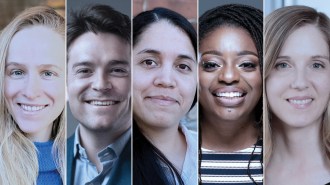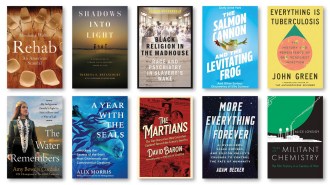Alaska’s free money for residents hints at how universal basic income may work
Annual payments from Alaska oil revenues offer data for research into a universal basic income

Alaskans wait in line to sign up for their share of the state’s oil revenues from the Alaska Permanent Fund. The annual payout — $1,606 per person this year — can provide clues about the pros and cons of a universal basic income.
Loren Holmes/Adn/Alaska Dispatch News/ZUMA Wire/Alamy Live News
Most everyone who has lived in Alaska for a year or more just got $1,606, no strings attached.
The annual giveaway shares the Arctic state’s oil revenues with its residents. But Alaska’s program, now in its 38th year, is also providing valuable data for research into universal basic income, or UBI — an idea gaining traction in public debate thanks in part to Democratic presidential candidate Andrew Yang making it a cornerstone of his campaign.
“The Alaska Permanent Fund [dividend] is the closest thing we have to a real-world UBI,” says Jesse Rothstein, an economist at the University of California, Berkeley.
Some studies suggest the Alaskan payments have coincided with overall poverty reductions and improvements to child health. But other research suggests a potential downside — giving everyone free money may further widen both the gender and wealth gap.
The amount distributed by the Alaska Permanent Fund can be significant for some. A family of four, for example, received a total of $6,424 during the 2019 giveaway on October 24. But depending on oil revenues, the Alaska handout can vary from a couple hundred dollars per person to several thousand. By contrast, Yang has called for every American adult to receive a flat $1,000 per month. He says it could help Americans cope with a changing job market. A universal basic income can also help compensate for inadequacy in social welfare programs, others contend.
No strings attached
Researchers quibble about whether the once-a-year Alaska dividend qualifies as a universal basic income. Such payments should be unconditional, extended to everyone and generous enough to live on, says economist Mouhcine Guettabi at the University of Alaska Anchorage. The Alaska dividend amounts to too little to support the third criterion. Still, he says, it provides powerful research data.
Take employment, for example. Critics suggest universal basic income programs might dissuade recipients from working. “In basic economic theory, the assumption is that people work in order to make an income, and that work is unpleasant,” says Ioana Marinescu, an economist at the University of Pennsylvania. As the theory goes, the payments offer “more income, so there is less of a pressing need to work.” But Marinescu’s research suggests the Alaska payouts haven’t had that effect.
Going part time
While critics of a universal basic income say it could deter recipients from working, Alaska has seen its full-time employment remain steady and an overall uptick in the percentage of people working part time (blue line) since its program to share oil revenues with residents started in 1982 (black vertical line). No similar increase occurred in a group of states — Utah, Wyoming, Washington, Nevada, Montana and Minnesota — with a similar employment profile but no similar annual payout (red line), according to an analysis by researchers. The team says it doesn’t know why the percentage of Alaskans working part time has dipped in recent years.
Percentage of Alaskans working part time, 1977–2014


The fact that Alaskan dividend goes to everyone means there is no built-in control group for researchers to use as a comparison. So Marinescu and her colleagues combined and weighted data from six other U.S. states with employment profiles similar to Alaska’s during the five years before the payouts began to create an Alaska-like point of comparison as a control. The researchers then compared its employment data with Alaska’s from 1982, when the payout program was implemented, through 2014.
The number of people working full time in Alaska stayed the same relative to the control after payments began. But the share of Alaskans working part time trended higher. It rose from 10 percent of the population — similar to that of the control — before the payouts began to 11.8 percent on average, and was consistently higher most years than in the comparison “state”, the researchers reported February 2018 in a working paper out of the National Bureau of Economic Research, or NBER.
Gender differences
The Alaska payments also may affect men and women differently, research suggests.
In a March 2019 NBER working paper, Guettabi and colleagues found that a $1,000 increase in the annual payment coincided with a 1.8 percent increase in employment for men up through December — likely due to short-term jobs generated by people spending more money. Overall, both men and women worked fewer hours in the three months following the payment. But that drop was statistically significant only for women, who worked almost an hour less per week — a 4 percent decrease. That finding was most pronounced among low-income women with children at home.
In another study published June 2018 in the B.E. Journal of Economic Analysis & Policy, labor economist Daniel Kuehn and his team found that when annual payments increased in size, married women reduced their working hours more than single women and men. Kuehn suspects married women are using the money to spend more time with their children. Because working hours for men don’t change as much, Kuehn, who is with the Urban Institute in Washington, DC, worries about the long-term consequences of a payment that’s not paired with other policy initiatives to keep women in the workforce. “If [women] reduce their hours, it will lead to a larger pay gap,” he says.
A wealth gap
Giving everybody money may also correlate with a widening wealth gap. Overall, the state’s growing wealth gap mirrors that of the whole country, according to U.S. Census Bureau data. But one 2017 paper in Energy Economics concluded that, in the three decades following the start of the dividend program, income inequality rose 21 percent faster in Alaska than it otherwise would have.
Similarly, sociologist Mariana Amorim at Washington State University in Pullman looked at data from the U.S. Bureau of Labor Statistics’ annual consumer spending survey from 1996 to 2015. During that time, Alaskan households received an average of $4,222 per year from the fund. A 1 percent increase in the annual payment amount for an Alaskan family of any socioeconomic class was followed by roughly a 5 percent increase on average in spending on children, mostly on clothing, she found. Amorim, whose findings have not been published yet, compared 911 Alaskan households with 49,855 households in other U.S. states as a control.
She found parents in middle- and high-income households increased spending — by about 4 to 5 percent — on non-academic activities such as arts, music and sports, which research suggests can help children get ahead in college and later life. These findings show one way in which inequality perpetuates from one generation to the next, Amorim says.

But another study — this one looking at a program run by North Carolina’s Eastern Band of Cherokee Indians to pay casino revenues to its members — suggests the benefits to children can be more widespread. The study, published in 2010 in the American Economic Journal: Applied Economics, found that by the time children from the poorest families reached age 21, an additional $4,000 per year increased the time those children spent in school by a full year. Researchers say the money also helps to reduce stressors within households, such as fighting and substance abuse.
Impact on child health
Some of the most striking findings from Alaska show that payments correlate with improvements in newborn and child health.
One 2016 analysis evaluated the health of babies born from 1978 to 1984, around the time payments started in 1982. An extra $1,000 in the annual payment correlated with a 17.7 gram increase on average in birthweight, or a little more than half an ounce, the researchers found. And the likelihood of babies being born at low birth weight was reduced by 14 percent. Those findings were most pronounced for less-educated mothers.

Meanwhile, Guettabi and his team took advantage of the fund’s eligibility requirements to see how the windfall affected young children. Children must be born in the year prior to the distribution to be eligible for a payment. That means that a child born in January 2019 can’t receive their first payment until late 2020, when they’re almost 2 years old. So Guettabi compared the outcomes of 884 children born between January 2009 and December 2011. By age 3, 31 of the children had received one payment, 492 had received two payments and 361 had received three.
A 3-year-old’s likelihood of obesity dropped by up to 4.5 percent for every extra $1,000 received, Geuttabi wrote in an April 2019 working paper in SSRN. The greatest benefit was seen among children in households earning from $25,000 to $75,000 per year. Guettabi says the next step will be to go into households to see why these benefits exist. His theory is that parents might be able to afford to buy healthier foods and to spend more time playing with their children.
With health gains from the payment concentrated at lower and middle income levels, and the possibility that giving money to everybody could widen existing disparities, some researchers question whether the payments should even go to those who are relatively well off. “This kind of money should be targeted at low-income recipients,” says Baek.
That approach takes the “universal” out of universal basic income, though. And there’s already a name for such programs: Welfare.







